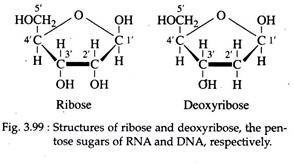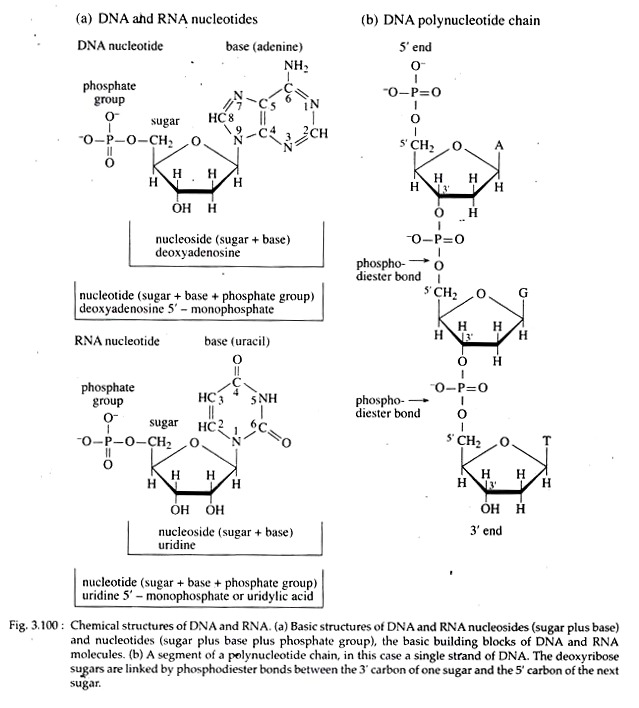Zoology Notes on the Nucleic Acids!
Introduction to Nucleic Acids:
Two nucleic acids – DNA and RNA are the principal informational molecules of the cell. Deoxyribonucleic acid (DNA) serves as the genetic material of all cellular organisms, though ribonucleic acid (RNA) carries out that role for many viruses. In cells, information stored in the DNA blue print is used to govern cellular activities through the formation of RNA messages.
DNA, in general, remains localized in the nucleus (in nucleoid of prokaryotes) within the cell. However, a small amount of DNA is found in mitochondria as mtDNA and chloroplast as cpDNA, that are referred to as extra-chromosomal or extra-nuclear DNA.
ADVERTISEMENTS:
On the other hand, RNAs are found both in the nucleus or nucleoid of prokaryotes where it is synthesized and in the cytoplasm where protein synthesis takes place. The structural components of DNA and RNA are very similar and this similarity is important in the co-ordinated functions played by these macromolecules during gene expression.
Chemistry of Nucleic acids:
Like other organic biomolecules (proteins, carbohydrates and lipids), nucleic acids are made of similar building blocks called nucleotide’s that are polymerized into chains of varying lengths. Nucleotides consist of three essential components: a nitrogenous base, a pentose sugar and a phosphate group.
Two types of nitrogenous bases are there — the nine- member double-ring purines and the six- member single-ring pyrimidine’s.
ADVERTISEMENTS:
Two types of purines and three types of pyrimidine’s are commonly found in nucleic acids. The two purines are adenine (A) and guanine (G) and the three pyrimidine’s are cytosine (C), thymine (T) and uracil (U) (Fig. 3.98). Among these bases, A, G and C are found both in DNA and RNA, T is present only in DNA, and U is present only in RNA.
The pentose sugars found in nucleic acids are in accordance to their names — ribonucleic acids or RNAs containing ribose sugar and deoxyribonucleic acid or DNA containing deoxyribose sugar.
The carbon atoms in the pentose sugar are numbered with a prim sign, e.g. C-1′ to C-5′ to distinguish them from the carbon and nitrogen atoms present in the rings of nitrogenous bases (the carbons and nitrogen’s of the purine rings are numbered from 1 to 9 and those of pyrimidine are numbered from 1 to 6) (Figs. 3.98 and 3.99).
ADVERTISEMENTS:
The deoxyribose sugar lacks one hydroxyl group at the C-2′ position, compared with ribose. The presence of a hydroxyl group at the C-2′ position distinguishes RNA from DNA (Fig. 3.99). The chemical unit composed of a purine or pyrimidine base and a ribose on deoxyribose sugar is called nucleoside.
Two types of nucleosides are present:
(i) Ribosides in RNA that include (a) adenosine (adenine + ribose), (b) guanosine (guanine + ribose), (c) cytidine (cytosine + ribose), and (d) uridine (uracil + ribose); and
(ii) De-oxy-ribosides in DNA that include (a) deoxyadenosine (b) deoxyguanosine (c) deoxycytidine and (d) de-oxy-thymidine. The sugar and bases are linked by N-B-glycosidic bond. The OH on C-1′ of sugar is linked with N-1 nitrogen of pyrimidine’s like cytosine, thymine and uracil. The OH on C-1′ of sugar is linked with N-9 nitrogen atom of purines like adenine and guanine (Fig. 3.100).
If a phosphate group is added to the nucleoside, the molecule is now called a nucleotide. So, a nucleotide is a nucleoside phosphate or nucleotides are phosphoric acid esters of nucleosides. Two types of nucleotides are ribonucleotide and deoxyribo nucleotide.
Ribonucleotides include adeno- sine-5′-monophosphate or adenylic acid or AMP, guanosine-5′-monophosphate or guanylic acid or GMP, cytidine-5′-mono- phosphate or cytidylic acid or CMP, and uridine-5 ‘-monophosphate or uridylic acid or UMP.
The deoxyribonucleotides are similar and known as dAMP or deoxyadenylic acid or deoxy-adenosine-5′-monophosphate, dGMP or deoxyguanylic’ acid or deoxy-guanosine-5′-monophosphate, dCMP or deoxycytidylic acid or deoxycytidine-5′- monophosphate and dTMP or deoxy- thymidylic acid or de-oxy-thymidine-5′- monophosphate.
Addition of two and three phosphate groups to nucleoside results in nucleoside diphosphates (e.g., ADP or adenosine diphosphate) and triphosphates (e.g., ATP or adenosine triphosphate) respectively. The nucleotides are joined with one another to form polynucleotide chain.
ADVERTISEMENTS:
Within a polynucleotide strand, the successive nucleotides are linked by a covalent bond between the phosphate group (attached to 5’C of the sugar ring) of one nucleotide and the 3′ carbon of the pentose sugar of another nucleotide. These 5′-3′ phosphate linkage are called phosphodiester bonds (Fig. 3.100b). Thus, the two ends of the chain are not same.
The chain has a 5′ carbon with a phosphate on it at one end and a 3′ carbon with a hydroxyl on it at the other end. This asymmetry is referred to as polarity of the chain. The joining of two nucleotides forms a dinucleotide; of three, trinucleotide; and so forth. Short chains consisting of fewer than 20 nucleotides linked together are called oligonucleotides. Still longer chains are referred to as polynucleotides.

